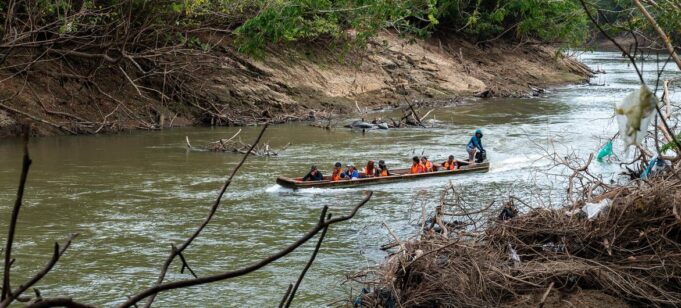Record numbers of children are on the move through Latin America and the Caribbean, facing perilous journeys marked by violence, exploitation and abuse, the UN Children’s Fund (UNICEF) warned in Sept. 5.
Children in the region driven from their homes by gang violence, instability, poverty and climate change represent around 25 percent of migrants said—almost double the global average of 13 percent.
“More and more children are on the move, of an increasingly young age, often alone and from diverse countries of origin, including from as far away as Africa and Asia,” said Garry Conille, UNICEF Latin America and the Caribbean Director.
“When they cross several countries and sometimes the entire region, disease and injury, family separation and abuse may plague their journeys and, even if they make it to their destination, their futures often remain at risk.”
Shocking numbers
Along the dangerous Darien jungle route alone, at least 29,000 children made the crossing in 2021, followed by an estimated 40,000 last year.
In just the first eight months of 2023, more than 60,000 children have made the trek, half of them under five—the highest number on record for a single year.
This trend is mirrored at the southern border of the United States, where authorities recorded over 83,000 children entering the country in the first seven months of fiscal year 2023, which runs from October the previous year to September.
In fiscal years 2022 and 2021, over 155,000 and 149,000 children crossings were recorded, respectively.
Root causes and challenges
According to UNICEF, the root causes of the crisis range from widespread poverty and job opportunities to structural inequality, food insecurity and accelerating climate change.
Disasters like hurricanes and earthquakes have further exacerbated internal displacement in the region and lingering impacts of the COVID-19 pandemic.
Migrant children also face grave physical risks. In 2022, at least 92 migrant children died or went missing due to natural hazards, violence, exploitation and abuse.
The dangers are amplified by limited access to healthcare, nutrition and protection services, especially for the most vulnerable, including children with disabilities, children identifying as LGBTQI+ and those from indigenous groups.
Response
UNICEF is actively working with partners and governments along migration routes to provide accurate information, promote safe migration and offer lifesaving assistance to children and families.
To address this unfolding crisis, the agency is appealing for $160.5 million to meet the needs of refugees and migrant children in several Latin American and Caribbean countries, including Brazil, Chile, Colombia, Guyana, Peru, Trinidad and Tobago, and others.
It is also calling for $142.3 million to support children and families on the migration route across Central America and Mexico in 2023. However, as of August, both appeals are less than a quarter funded.
UNICEF also urged Member States to mobilize a better regional approach, invest in countries of origin, expand safe migration pathways, and strengthen child-sensitive border and reception processes.
“The unprecedented scale of the child migration crisis in Latin America and the Caribbean urgently requires a stronger humanitarian response as well as the expansion of safe and regular migration pathways for children and families to help protect their rights and their futures, no matter where they are from,” said Mr. Conille. (UN News)
Brazilian Indigenous women use fashion to showcase their claim to rights and the demarcation of land
BRASILIA, Brazil—Indigenous women in Brazil’s capital Brasilia showcased their creations during a fashion event as part of the Third March of Indigenous Women to claim women’s rights and the demarcation of Indigenous lands.
Under a huge white marquee, models in headdresses, necklaces and traditional attire strutted along a catwalk lined with green foliage to the cheers of a couple of hundred onlookers, many of whom had their smartphones out to share the event on social networks.
Kajina Maneira da Costa, from the Nukini people in Acre state, near the border with Peru, said she was nervous before taking to the stage, but was proud to be representing her people.
“There still exists a lot of prejudice. It’s not normal to see an Indigenous fashion show,” the 19-year-old said.
Kitted out in a bright yellow dress and headdress, Célia Xakriabá, a federal lawmaker from the southeastern state of Minas Gerais, said on stage that the event was about “decolonizing fashion.”
“Today we showed the power of our creation in clothing … our headdresses and our ancestry. We participate in politics when we sing and parade,” Xakriabá added later in a post on Instagram.
Xakriabá was voted in during last year’s October elections, at the same time as Brazilian President Luiz Inácio Lula da Silva defeated far-right incumbent Jair Bolsonaro.
Since taking office in January, Lula has given significantly more attention to the demands of Indigenous peoples than his predecessor. Bolsonaro opposed Indigenous rights, refused to expand Indigenous territories and had a record of statements critics called racist.
In Lula’s third, non-consecutive term, eight Indigenous territories have been demarcated, and he created the country’s first Ministry of Indigenous Peoples, headed by Indigenous woman Sonia Guajajara.
Indigenous women are increasingly center stage on Brazil’s political scene, and even within their communities. The Third March of Indigenous Women, which took place from Sept. 11 to 13, is a testament to their growing movement.
“Indigenous men had visibility, but now women are adding their strength to the defense of their territory too,” said Ana Paula da Silva, a researcher at Rio de Janeiro State University’s Indigenous peoples study program.
“They are marching to say ‘we are here’ and it’s no longer possible to keep ignoring us,” she added. (AP)













